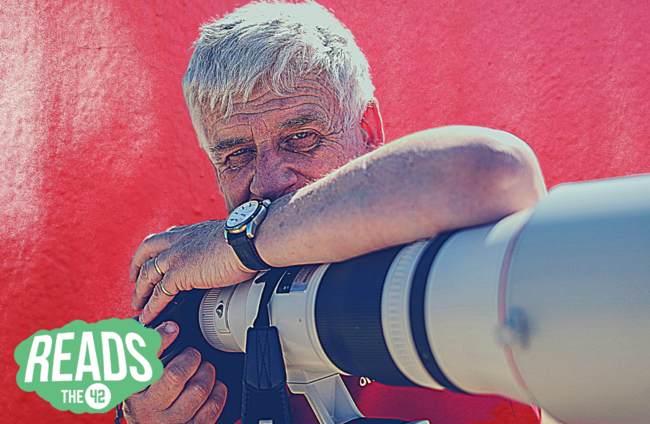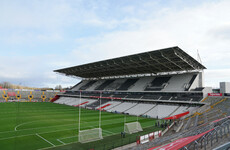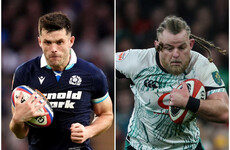FOR SPORTS PHOTOGRAPHERS, the search for the perfect picture often appears more painful than Lancelot’s search for the Holy Grail. There’s always something wrong or someone in the way; a person smiling when they should be sulking; a technical flaw; a shutter pressed a millisecond too late.
Billy Stickland has been on the hunt for what seems like forever, since 1981 in a professional capacity, since 1989 when he went to Australia to cover the Lions. That tour was his first; this one is his eighth. Even Willie John McBride stopped when he got to five.
A long time ago, Stickland reckoned the 1997 series would be his last, yet here he is, 24 years later, thousands of miles from home, having left his house on 12 June, knowing he won’t be back there until 9 August. Yes, there are worse things to do for a living but this is still a passion, born on a sunny day in 1971.
“As a kid, there is no real reason why you get into something, why you support such and such a team; some followed Liverpool, others Manchester United,” said Stickland, who founded the picture agency, Inpho, over 30 years ago. “For me, it was the Lions. I became a real fan when I first saw the Barry Johns, the Gareth Edwards, the Willie John McBrides. I just thought it was amazing.”
He still does, so much so that he keeps getting drawn back to it, even in Covid times, when he can’t sneak off for a pint after work, when there aren’t crowds in the grounds to add a splash of colour. “What gets to me about the Lions is the fact it only happens every four years; that it comes along, is there for two months and then disappears. That’s unique. It’s what I love about it.”
Love works in mysterious ways. These days everything is planned and ordered. Down-days when players are out golfing, there is a market even for those pictures. Way back in 1989, there wasn’t. So in between Tests, the pool of photographers jetted north to Cairns for a four-day holiday. “The spontaneity has gone from tours,” Stickland says, “but the fun hasn’t. Far from it.”
Still, you can’t compare then with now. There weren’t Covid-type restrictions in 1989; indeed there were barely any hindrances at all. Dressing-room doors stayed open; players, reporters and photographers drank together. Life was straightforward, very black and white you could say. Even the photos were.
THEN AND NOW
The picture above is enhanced by the monochrome style but that’s not the only thing that catches the eye. It’s the background. Set in the Lions dressing room after the victorious third Test, the smiling faces of Ian McGeechan and Finlay Calder only tell half the story. Relaxing after a win, there is no need to tense up because of the presence of a snapper in their midst.
There are three people in the picture, none of whom even appear to be aware that Stickland is there, capturing not just their expressions but also the chaos of a post-match dressing-room; the discarded socks, jerseys, the half-open lockers, the pants that have slipped off their peg onto a chair. It could be any dressing room, any sport, any time.
“It was completely different to now,” Stickland says. “Everything about that tour was so straightforward. Prior to flying out to Australia, the Lions had training in London, so I flew over, bought a replica jersey at the airport, and brought it to the practice session where I asked one player after the next if they could put it on, so that I could take a head and shoulders shot. They all said fine, no problem.
“Nowadays that sort of thing would have to be organised if it was to happen at all. Then, there was no media liaison officer, no commercial team. You’d the coach, the doctor, the tour manager, the physio and the players. That was it.
“As far as we were concerned, in those days, you just shot film and then got it processed the day after the match. It was a long process. Nowadays the demands are ridiculous; you have to get photos sent back within five minutes of a match starting.
“Getting into the dressing room that time, it was no big deal. The match ended, the players returned to the changing room. We wandered in after them. No one tried to stop you. There was no security or anything like that. That has all changed.
“I wasn’t on the 1993 tour but I chatted to the photographers who did travel. They all got hammered with the team after they won the second Test. Generally there is more suspicion now around elite squads.”
BUT THIS TIME …..
“It is really odd in that we have not had a chance to even go for a coffee or buy a newspaper outside the hotel.
“I’ve toured here a few times and going through Cape Town the other night, I remembered all the great nights out we had over the years at various restaurants. This time we have been stuck to our hotel and while the media have all been reporting about the tour going into free-fall against the background of what is happening politically across South Africa, it doesn’t feel like this on the inside. Everyone makes an extra effort to be helpful to each other. Whether or not this changes when the Tests start we’ll have to see. It is just so different to all the other tours I’ve been on.”
GATLAND: LEADER OF MEN
Billy Stickland has known Warren Gatland for a quarter of a century, dating back to when the New Zealander was coaching Galwegians, then Connacht, later Ireland. In 2001, they colloborated on a pictorial book, a glance through the dressing room window of the Ireland camp. To get the idea off the ground, Stickland had to pitch it to the team’s coach and captain, Gatland and Keith Wood.
Gatland, who’d been part of documentaries when he was a squad player with the All Blacks, immediately saw the benefit of it and has remained friendly with Stickland since, inviting him to his house for drinks on the 2005 Lions tour to New Zealand, working closely with him on this tour.
“What seems to work for Warren is his man-management; the way he really looks at the human side of things,” Stickland says. “He has this saying ‘family comes first’ so if anybody has issues, he makes it clear that everyone is here to support them. I’ve huge admiration for the man as a head coach because you need someone who understands the issues involved on a lengthy tour. You can see how his humour shines through at certain moments, how he allows people to relax at times when other coaches would like them to work.
“You often see him going around talking to players in one-on-ones. He, like Ian McGeechan before him, has enormous emotional intelligence. This isn’t like, say, being in charge of a club side; you have to know when to be silent, when to deliver a speech laden with emotion. You can’t say the same things day in and day out. I’ve been in some of his team meetings. He has the ability to get players to perform above the level they do for their country. That is impressive.”
Clive Woodward: from knighthood to nightmare
In 2003, Clive Woodward stopped being plain old Clive Woodward. He became a Knight Bachelor of the United Kingdom, a World Cup winner. He was given an audience with the Queen in Buckingham Palace; his team had a homecoming parade through central London. He was Sir Clive, a hero.
Two years later, he was a loser. The fickleness and cruelty of sport etched across his face in the picture below.
“Alastair Campbell was there as media officer on that tour and was treating it like a full-on political campaign, setting agendas, trying to be too clever.
“On that tour, the players weren’t sharing rooms, one of the core ideas of getting guys to become closer; the midweek team barely mixed with the Test team because they had different schedules to stick to. The background noise to all these ideas was that they were not going to work.
“They then came up against a brilliant All Blacks team who beat them out the gate; you had O’Driscoll’s injury, the humiliation on the scoreboard and the inevitable photograph which followed. The 2017 All Blacks were also a very good team but dealt with a more connected opponent. You knew in 2005 that it was going to be a disaster. This photograph of Clive Woodward (above) illustrates it for me.”
THE SPIN DOCTOR
Journalists have a saying about certain PR people. “You can’t live with them …….”
Sixteen years on, it still seems a bit mad that someone like Campbell would be selected to tour. He’d guided Tony Blair through general elections, an Iraq war; a constitutional crisis. Now he was advising Woodward ahead of fixtures against the Bay of Plenty and Taranaki.
“He was a friendly, affable, intelligent guy, full of good stories,” says Stickland. “But he can be utterly ruthless and single-minded at the same time. There was a thing on the 2005 tour where it became clear Gavin Henson was not going to be playing in the first Test; so they set up a photograph of Gavin talking to Clive Woodward with the photographer planted somewhere where he could not be seen, the idea being that Gavin would be captured smiling with the head coach, part of one big, happy, family.
“I was there when one of the journalists was going to interview Alastair and knew he was going to ask about the Henson picture. Alastair asked if I wanted to take the photograph before or after the interview. Knowing what was coming up, I said before. I took the photograph and Alastair was great, very helpful. I then went about my business processing it.
“As I was doing so, I distinctly heard the question about Henson. Straightaway, the tone changed. However, the journalist was very capable of coping with Campbell.”
The spin doctor became one of the biggest stories of that tour: “You need your media officers to understand that sport is in the toy department really and shouldn’t be taken too seriously.”
STUCK IN THE MUD
Nowadays all pitches are dry; beautifully manicured. But there was a time when mud and rugby went together like gin and tonic. Stickland’s second Lions tour, the South African one in 1997, serves as a reminder of how it used to be: a ruck, players piled on top of one another, the ball squeezing out, no one knowing where it was.
“If you are in the right position, and something like that happens, it is just kind of good; it is different,” says Stickland. “I was very happy with that picture. That kind of image isn’t seen anymore.”
BOD: A TRAGEDY IN FOUR ACTS
Brian O’Driscoll’s Lions story had a bit of everything. He was the have-a-go hero in 2001; the captain whose tour was cynically ended early in ’05; a warrior in ’09; a rejected figure in 2013. While his career seemingly was one long tale of glory, the reality was different. There were setbacks and heartaches, injuries and losses.
By the time the conspiracy theorists analysed Gatland’s decision to drop him from the deciding test of the 2013 tour, the whole thing felt a bit Shakespearean, O’Driscoll the tragic victim, Gatland the anti-hero.
Observing all this through a lens, Stickland saw a fascinating figure mature over 12 years and four tours.
“A lot of players suffer from thinking they aren’t good enough; Jonny Wilkinson being the classic example. I always thought, ‘gosh, what a waste’. But O’Driscoll knew what he had and was able to enjoy it. He had an incredible career but he was a bit unfulfilled with the Lions.
“His 2001 try in the first Test was extraordinary. But the Lions lost that series.
“In 2005, there was the shoulder injury from that spear tackle.
“In 2009, he was really good, but got beaten up a bit in the second Test.
“And by 2013, he was playing really well but got dropped. That had never happened him before; it was a huge thing at the time.
“He reacted really well to the decision, I remember a training session with kids just after the decision was made and he was great at that, encouraging them.
“He can have no regrets; he got to choose when to go, that is not a privilege many players have. Many players have a fear of failure; O’Driscoll didn’t have that. He can look back on a great career.”
He isn’t the only one.




















Ripped the seat of my pants on the V-Sit and unleashed the beast. It unfurled 7 inches past the line. Does that count?
We really need to take care while building muscles because it can take away our flexibility.I we don’t give importance to flexibility we will feel weird. fromdeeptothesurfaces.com